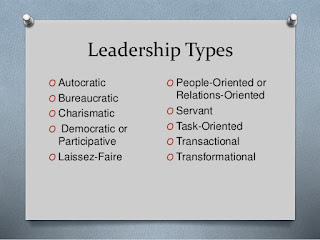An Insight into Leadership Types
Transactional
In transactional style people are motivates through rewards and
punishments. Employees receive rewards such as bonuses when they accomplish
goals. Under this leadership style, the primary duty of subordinates is to do
what their manager has assigned them to do.
Transformational
This leadership style depends on high levels of communication
between management and employees to meet goals. Leader encourages employees and
enhance productivity through communication and high visibility. Leaders focus
on the crucial issues of the organization and delegate smaller tasks to the
team members to attain objectives.
Laissez-Faire
The laissez-faire leaders do not perform
direct supervision of employees. They never provide weekly or monthly feedback to
their staff. Highly experienced and well trained employees requiring little
guidance fall under the laissez-faire leadership style. The disadvantages of
laissez-faire style are low production, no control and high costs.
Autocratic
The autocratic leadership style gives managers solo decision making
power without acquiring advice of others. Managers practice complete authority
and impose their own choice on employees. No one can challenge the decisions
under autocratic leadership style.
Participative
This usually called democratic leadership style, participative leadership
style invites team members and peers for decision making, but the
responsibility of making the final decision rests with the participative
leader. It motivates employees and provides high self esteem. This style helps
attain the challenges, when there is a need to make immediate decisions.
AIMAN SOHAIL




Comments
Post a Comment